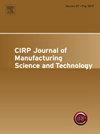Insights into the fabrication of microchannels on biomedical NiTinol
IF 4.6
2区 工程技术
Q2 ENGINEERING, MANUFACTURING
CIRP Journal of Manufacturing Science and Technology
Pub Date : 2025-02-01
DOI:10.1016/j.cirpj.2024.12.003
引用次数: 0
Abstract
The nickel-titanium alloy (NiTinol) exhibits shape memory and superelasticity behavior, stemming from its remarkable ability to alter the atomic bonding types and mechanical properties significantly. NiTtinol is utilized in biomedical as well as aerospace applications. However, as reported by the recent literature, achieving the desired machinability characteristics on NiTinol at macro as well as micro levels is considerably challenging. In this context, this study aims to investigate the machinability of Biomedical grade NiTinol during its micromilling with minimum quantity lubrication (MQL), primarily focusing on the tool wear evolution, wear mechanisms, surface roughness, and burr formation. In addition, the frequency spectrum of the surface roughness profile was analyzed. For this purpose, experiments were conducted comprising the fabrication of microchannels measuring 27.0 mm in length using TiAlN coated 400 µm diameter micro end mills. A cutting speed of 12.57 m/min, feed rate of 1 µm/tooth, and axial depth of cut of 40 µm were employed. The results revealed that the formation of built-up edge (BUE) served as a protective barrier for the cutting-edge of the microtools, with adhesion or attrition identified as the predominant wear mechanisms. The measured surface roughness value Ra ranged from 0.0411 ± 0.0040 µm to 0.0461 ± 0.0070 µm. The frequency spectrum of the roughness profile analysis detected that feed rate was not the primary factor. Finally, the burr height and area on the down-milling side were consistently found to be larger than those observed on the up-milling side.
生物医用镍钛诺微通道制备的研究进展
镍钛合金(NiTinol)具有形状记忆和超弹性特性,这源于其显著改变原子键合类型和机械特性的能力。镍钛诺可用于生物医学和航空航天领域。然而,根据最新文献报道,要在宏观和微观层面上实现镍钛诺所需的机械加工特性具有相当大的挑战性。在此背景下,本研究旨在研究生物医学级镍钛诺在使用最小量润滑(MQL)进行微孔加工时的可加工性,主要关注刀具磨损演变、磨损机制、表面粗糙度和毛刺形成。此外,还分析了表面粗糙度曲线的频谱。为此,实验包括使用直径为 400 µm 的 TiAlN 涂层微型立铣刀制造长度为 27.0 mm 的微通道。切削速度为 12.57 米/分钟,进给速度为 1 微米/齿,轴向切削深度为 40 微米。结果表明,堆积刃(BUE)的形成对微型刀具的切削刃起到了保护作用,粘附或磨损是主要的磨损机制。测得的表面粗糙度值 Ra 在 0.0411 ± 0.0040 µm 到 0.0461 ± 0.0070 µm 之间。粗糙度轮廓的频谱分析表明,进给率不是主要因素。最后,发现下铣侧的毛刺高度和面积始终大于上铣侧的毛刺高度和面积。
本文章由计算机程序翻译,如有差异,请以英文原文为准。
求助全文
约1分钟内获得全文
求助全文
来源期刊

CIRP Journal of Manufacturing Science and Technology
Engineering-Industrial and Manufacturing Engineering
CiteScore
9.10
自引率
6.20%
发文量
166
审稿时长
63 days
期刊介绍:
The CIRP Journal of Manufacturing Science and Technology (CIRP-JMST) publishes fundamental papers on manufacturing processes, production equipment and automation, product design, manufacturing systems and production organisations up to the level of the production networks, including all the related technical, human and economic factors. Preference is given to contributions describing research results whose feasibility has been demonstrated either in a laboratory or in the industrial praxis. Case studies and review papers on specific issues in manufacturing science and technology are equally encouraged.
 求助内容:
求助内容: 应助结果提醒方式:
应助结果提醒方式:


